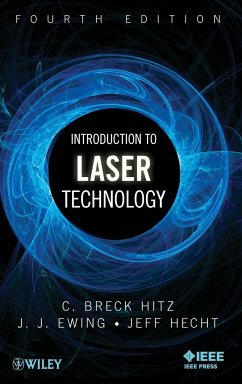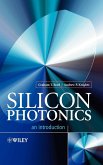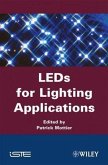- Gebundenes Buch
- Merkliste
- Auf die Merkliste
- Bewerten Bewerten
- Teilen
- Produkt teilen
- Produkterinnerung
- Produkterinnerung
The only introductory text to explain the underlying physics and engineering applicable to all lasers, Introduction to Laser Technology presents a unique combination of clarity and technical depth. The book features an introductory chapter explaining the characteristics and important applications of commercial lasers worldwide as well as discussions on light and optics, the fundamental elements of lasers, and laser modification. This fourth edition includes a new chapter on fiber lasers, a discussion of arrays in the semiconductor, and new end-of-chapter problems for technicians, laser-safety officers, and students.…mehr
Andere Kunden interessierten sich auch für
![Laser in Manufacturing Laser in Manufacturing]() Laser in Manufacturing202,99 €
Laser in Manufacturing202,99 €![Analysis and Design of Vertical Cavity Surface Emitting Lasers Analysis and Design of Vertical Cavity Surface Emitting Lasers]() S. F. YuAnalysis and Design of Vertical Cavity Surface Emitting Lasers208,99 €
S. F. YuAnalysis and Design of Vertical Cavity Surface Emitting Lasers208,99 €![Leoma and the Us Laser Industry Leoma and the Us Laser Industry]() C. Breck HitzLeoma and the Us Laser Industry114,99 €
C. Breck HitzLeoma and the Us Laser Industry114,99 €![Fundamentals of Light Sources and Lasers Fundamentals of Light Sources and Lasers]() Mark CseleFundamentals of Light Sources and Lasers202,99 €
Mark CseleFundamentals of Light Sources and Lasers202,99 €![Military Laser Technology Military Laser Technology]() Alastair D. McAulayMilitary Laser Technology114,99 €
Alastair D. McAulayMilitary Laser Technology114,99 €![Silicon Photonics Silicon Photonics]() Graham T. ReedSilicon Photonics190,99 €
Graham T. ReedSilicon Photonics190,99 €![Led for Lighting Applications Led for Lighting Applications]() Patrick MottierLed for Lighting Applications193,99 €
Patrick MottierLed for Lighting Applications193,99 €-
-
-
The only introductory text to explain the underlying physics and engineering applicable to all lasers, Introduction to Laser Technology presents a unique combination of clarity and technical depth. The book features an introductory chapter explaining the characteristics and important applications of commercial lasers worldwide as well as discussions on light and optics, the fundamental elements of lasers, and laser modification. This fourth edition includes a new chapter on fiber lasers, a discussion of arrays in the semiconductor, and new end-of-chapter problems for technicians, laser-safety officers, and students.
Hinweis: Dieser Artikel kann nur an eine deutsche Lieferadresse ausgeliefert werden.
Hinweis: Dieser Artikel kann nur an eine deutsche Lieferadresse ausgeliefert werden.
Produktdetails
- Produktdetails
- Verlag: Wiley & Sons
- 4. Aufl.
- Seitenzahl: 320
- Erscheinungstermin: 10. April 2012
- Englisch
- Abmessung: 240mm x 161mm x 21mm
- Gewicht: 640g
- ISBN-13: 9780470916209
- ISBN-10: 0470916206
- Artikelnr.: 33717162
- Herstellerkennzeichnung
- Libri GmbH
- Europaallee 1
- 36244 Bad Hersfeld
- gpsr@libri.de
- Verlag: Wiley & Sons
- 4. Aufl.
- Seitenzahl: 320
- Erscheinungstermin: 10. April 2012
- Englisch
- Abmessung: 240mm x 161mm x 21mm
- Gewicht: 640g
- ISBN-13: 9780470916209
- ISBN-10: 0470916206
- Artikelnr.: 33717162
- Herstellerkennzeichnung
- Libri GmbH
- Europaallee 1
- 36244 Bad Hersfeld
- gpsr@libri.de
C. Breck Hitz is Executive Director of LEOMA, the Laser and Electro-Optics Manufacturers' Association. He was the founding editor of Lasers & Applications magazine, and a former editor of Laser Focus World. J. J. Ewing is the President of Ewing Technology Associates, Inc. His pioneering work on high-efficiency, ultraviolet lasers led to the discovery and development of the rare gas halide excimer lasers. Jeff Hecht is a contributing editor to Laser Focus World and correspondent for New Scientist magazine. He was a cofounder and contributing editor to Lasers & Applications. Mr. Hecht is the author of ten books, including Understanding Lasers: An Entry-Level Guide (Wiley-IEEE Press).
Preface ix
Acknowledgments xi
Chapter 1 An Overview of Laser Technology 1
1.1 What are Lasers Used For? 2
1.2 Lasers in Telecommunications 3
1.3 Lasers in Research and Medicine 4
1.4 Lasers in Graphics and Grocery Stores 4
1.5 Lasers in the Military 5
1.6 Other Laser Applications 5
Chapter 2 The Nature of Light 7
2.1 Electromagnetic Waves 7
2.2 Wave-Particle Duality 10
Chapter 3 Refractive Index, Polarization, and Brightness 17
3.1 Light Propagation-Refractive Index 17
3.2 Huygens' Principle 21
3.3 Polarization 24
3.4 Polarization Components 27
3.5 Birefringence 30
3.6 Brewster's Angle 36
3.7 Brightness 41
Chapter 4 Interference 43
4.1 What is Optical Interference? 43
4.2 Everyday Examples of Optical Interference 45
4.3 Young's Double-Slit Experiment 46
4.4 Fabry-Perot Interferometer 49
Chapter 5 Laser Light 55
5.1 Monochromaticity 55
5.2 Directionality 56
5.3 Coherence 60
Chapter 6 Atoms, Molecules, and Energy Levels 63
6.1 Atomic Energy Levels 63
6.2 Spontaneous Emission and Stimulated Emission 65
6.3 Molecular Energy Levels 66
6.4 Some Subtle Refinements 64
Chapter 7 Energy Distributions and Laser Action 73
7.1 Boltzmann Distribution 73
7.2 Population Inversion 76
7.3 L.A.S.E.R. 79
7.4 Three-Level and Four-Level Lasers 82
7.5 Pumping Mechanisms 83
Chapter 8 Laser Resonators 87
8.1 Why a Resonator? 87
8.2 Circulating Power 88
8.3 Gain and Loss 90
8.4 Another Perspective on Saturation 91
8.5 Relaxation Oscillations 93
8.6 Oscillator-Amplifiers 94
8.7 Unstable Resonators 95
8.8 Laser Mirrors 95
Chapter 9 Resonator Modes 99
9.1 Spatial Energy Distributions 99
9.2 Transverse Resonator Modes 100
9.3 Gaussian-Beam Propagation 101
9.4 A Stability Criterion 107
9.5 Longitudinal Modes 109
Chapter 10 Reducing Laser Bandwidth 113
10.1 Measuring Laser Bandwidth 113
10.2 Laser-Broadening Mechanisms 116
10.3 Reducing Laser Bandwidth 118
10.4 Single-Mode Lasers 122
Chapter 11 Q-S witching 129
11.1 Measuring the Output of Pulsed Lasers 129
11.2 Q-Switching 135
11.3 Types of Q-S witches 135
11.4 Mechanical Q-Switches 135
11.5 A-0 Q-Switches 136
11.6 E-O Q-Switches 138
11.7 Dye Q-Switches 140
Chapter 12 Cavity Dumping and Modelocking 143
12.1 Cavity Dumping 143
12.2 Partial Cavity Dumping 147
12.3 Modelocking-Time Domain 147
12.4 Modelocking-Frequency Domain 151
12.5 Applications of Modelocked Lasers 152
12.6 Types of Modelocked Lasers 153
Chapter 13 Nonlinear Optics 155
13.1 What is Nonlinear Optics? 155
13.2 Second-Harmonic Generation 158
13.3 Birefringent Phase Matching 161
13.4 Quasi-Phasematching 165
13.5 Intracavity Harmonic Generation 168
13.6 Higher Harmonics 169
13.7 Optical Parametric Oscillation 170
13.8 Raman lasers 172
Chapter 14 Semiconductor Lasers 175
14.1 Semiconductor Physics 175
14.2 Modern Diode Lasers 181
14.3 Diode Laser Bandwidth 182
14.4 Wavelength of Diode Lasers 183
14.5 Diode Arrays and Stacks 185
14.6 Vertical Cavity, Surface-Emitting Lasers 185
14.7 Optically Pumped Semiconductor Lasers 187
14.8 Quantum Cascade Lasers 189
Chapter 15 Solid-State Lasers 191
15.1 Solid-State Laser Materials 191
15.2 Diode-Pumped Solid State Lasers 195
15.2.1 Diode-Pumping Geometry 199
15.2.2 Pump Diodes, Pulsing, and Packaging 199
15.3 Lamp Pumping 201
15.4 Thermal Issues in Solid-State Lasers 205
15.5 Scaling Diode-Pumped Lasers to High Power 207
Chapter 16 Fiber Lasers 215
16.1 Acceptance Angle and Numerical Aperture 215
16.2 Doping Optical Fibers 216
16.3 Pumping Fiber Lasers 217
16.4 Fabricating Optical Fibers 218
16.5 Feedback for Fiber Lasers 219
16.6 High Power Fiber Lasers 220
16.7 Large-Mode-Area Fibers 221
16.8 Holey Fibers 222
Chapter 17 Gas lasers: Helium-Neon and Ion 225
17.1 Gas-Laser Transitions 226
17.2 Gas-Laser Media and Tubes 227
17.3 Laser Excitation 229
17.4 Optical Characteristics 230
17.5 Wavelengths and Spectral Width 230
17.6 He-Ne Lasers 232
17.7 Principles of He-Ne Lasers 232
17.8 Structure of He-Ne Lasers 234
17.9 Ar-and Kr-Ion Lasers 235
Chapter 18 Carbon Dioxide and Other Vibrational Lasers 239
18.1 Vibrational Transitions 240
18.2 Excitation 242
18.3 Types of CO2 Lasers 243
18.4 Optics for CO2 Lasers 246
18.5 Chemical Lasers 246
Chapter 19 Excimer Lasers 249
19.1 Excimer Molecules 251
19.2 Electrical Considerations 253
19.3 Handling the Gases 255
19.4 Applications of Excimer Lasers 259
Chapter 20 Tunable and Ultrafast Lasers 263
20.1 Dye Lasers 265
20.2 Tunable Solid-State Lasers 268
20.3 Nonlinear Converters 271
20.4 Ultrafast Lasers 274
Glossary 283
Further Reading 291
Index 293
Acknowledgments xi
Chapter 1 An Overview of Laser Technology 1
1.1 What are Lasers Used For? 2
1.2 Lasers in Telecommunications 3
1.3 Lasers in Research and Medicine 4
1.4 Lasers in Graphics and Grocery Stores 4
1.5 Lasers in the Military 5
1.6 Other Laser Applications 5
Chapter 2 The Nature of Light 7
2.1 Electromagnetic Waves 7
2.2 Wave-Particle Duality 10
Chapter 3 Refractive Index, Polarization, and Brightness 17
3.1 Light Propagation-Refractive Index 17
3.2 Huygens' Principle 21
3.3 Polarization 24
3.4 Polarization Components 27
3.5 Birefringence 30
3.6 Brewster's Angle 36
3.7 Brightness 41
Chapter 4 Interference 43
4.1 What is Optical Interference? 43
4.2 Everyday Examples of Optical Interference 45
4.3 Young's Double-Slit Experiment 46
4.4 Fabry-Perot Interferometer 49
Chapter 5 Laser Light 55
5.1 Monochromaticity 55
5.2 Directionality 56
5.3 Coherence 60
Chapter 6 Atoms, Molecules, and Energy Levels 63
6.1 Atomic Energy Levels 63
6.2 Spontaneous Emission and Stimulated Emission 65
6.3 Molecular Energy Levels 66
6.4 Some Subtle Refinements 64
Chapter 7 Energy Distributions and Laser Action 73
7.1 Boltzmann Distribution 73
7.2 Population Inversion 76
7.3 L.A.S.E.R. 79
7.4 Three-Level and Four-Level Lasers 82
7.5 Pumping Mechanisms 83
Chapter 8 Laser Resonators 87
8.1 Why a Resonator? 87
8.2 Circulating Power 88
8.3 Gain and Loss 90
8.4 Another Perspective on Saturation 91
8.5 Relaxation Oscillations 93
8.6 Oscillator-Amplifiers 94
8.7 Unstable Resonators 95
8.8 Laser Mirrors 95
Chapter 9 Resonator Modes 99
9.1 Spatial Energy Distributions 99
9.2 Transverse Resonator Modes 100
9.3 Gaussian-Beam Propagation 101
9.4 A Stability Criterion 107
9.5 Longitudinal Modes 109
Chapter 10 Reducing Laser Bandwidth 113
10.1 Measuring Laser Bandwidth 113
10.2 Laser-Broadening Mechanisms 116
10.3 Reducing Laser Bandwidth 118
10.4 Single-Mode Lasers 122
Chapter 11 Q-S witching 129
11.1 Measuring the Output of Pulsed Lasers 129
11.2 Q-Switching 135
11.3 Types of Q-S witches 135
11.4 Mechanical Q-Switches 135
11.5 A-0 Q-Switches 136
11.6 E-O Q-Switches 138
11.7 Dye Q-Switches 140
Chapter 12 Cavity Dumping and Modelocking 143
12.1 Cavity Dumping 143
12.2 Partial Cavity Dumping 147
12.3 Modelocking-Time Domain 147
12.4 Modelocking-Frequency Domain 151
12.5 Applications of Modelocked Lasers 152
12.6 Types of Modelocked Lasers 153
Chapter 13 Nonlinear Optics 155
13.1 What is Nonlinear Optics? 155
13.2 Second-Harmonic Generation 158
13.3 Birefringent Phase Matching 161
13.4 Quasi-Phasematching 165
13.5 Intracavity Harmonic Generation 168
13.6 Higher Harmonics 169
13.7 Optical Parametric Oscillation 170
13.8 Raman lasers 172
Chapter 14 Semiconductor Lasers 175
14.1 Semiconductor Physics 175
14.2 Modern Diode Lasers 181
14.3 Diode Laser Bandwidth 182
14.4 Wavelength of Diode Lasers 183
14.5 Diode Arrays and Stacks 185
14.6 Vertical Cavity, Surface-Emitting Lasers 185
14.7 Optically Pumped Semiconductor Lasers 187
14.8 Quantum Cascade Lasers 189
Chapter 15 Solid-State Lasers 191
15.1 Solid-State Laser Materials 191
15.2 Diode-Pumped Solid State Lasers 195
15.2.1 Diode-Pumping Geometry 199
15.2.2 Pump Diodes, Pulsing, and Packaging 199
15.3 Lamp Pumping 201
15.4 Thermal Issues in Solid-State Lasers 205
15.5 Scaling Diode-Pumped Lasers to High Power 207
Chapter 16 Fiber Lasers 215
16.1 Acceptance Angle and Numerical Aperture 215
16.2 Doping Optical Fibers 216
16.3 Pumping Fiber Lasers 217
16.4 Fabricating Optical Fibers 218
16.5 Feedback for Fiber Lasers 219
16.6 High Power Fiber Lasers 220
16.7 Large-Mode-Area Fibers 221
16.8 Holey Fibers 222
Chapter 17 Gas lasers: Helium-Neon and Ion 225
17.1 Gas-Laser Transitions 226
17.2 Gas-Laser Media and Tubes 227
17.3 Laser Excitation 229
17.4 Optical Characteristics 230
17.5 Wavelengths and Spectral Width 230
17.6 He-Ne Lasers 232
17.7 Principles of He-Ne Lasers 232
17.8 Structure of He-Ne Lasers 234
17.9 Ar-and Kr-Ion Lasers 235
Chapter 18 Carbon Dioxide and Other Vibrational Lasers 239
18.1 Vibrational Transitions 240
18.2 Excitation 242
18.3 Types of CO2 Lasers 243
18.4 Optics for CO2 Lasers 246
18.5 Chemical Lasers 246
Chapter 19 Excimer Lasers 249
19.1 Excimer Molecules 251
19.2 Electrical Considerations 253
19.3 Handling the Gases 255
19.4 Applications of Excimer Lasers 259
Chapter 20 Tunable and Ultrafast Lasers 263
20.1 Dye Lasers 265
20.2 Tunable Solid-State Lasers 268
20.3 Nonlinear Converters 271
20.4 Ultrafast Lasers 274
Glossary 283
Further Reading 291
Index 293
Preface ix
Acknowledgments xi
Chapter 1 An Overview of Laser Technology 1
1.1 What are Lasers Used For? 2
1.2 Lasers in Telecommunications 3
1.3 Lasers in Research and Medicine 4
1.4 Lasers in Graphics and Grocery Stores 4
1.5 Lasers in the Military 5
1.6 Other Laser Applications 5
Chapter 2 The Nature of Light 7
2.1 Electromagnetic Waves 7
2.2 Wave-Particle Duality 10
Chapter 3 Refractive Index, Polarization, and Brightness 17
3.1 Light Propagation-Refractive Index 17
3.2 Huygens' Principle 21
3.3 Polarization 24
3.4 Polarization Components 27
3.5 Birefringence 30
3.6 Brewster's Angle 36
3.7 Brightness 41
Chapter 4 Interference 43
4.1 What is Optical Interference? 43
4.2 Everyday Examples of Optical Interference 45
4.3 Young's Double-Slit Experiment 46
4.4 Fabry-Perot Interferometer 49
Chapter 5 Laser Light 55
5.1 Monochromaticity 55
5.2 Directionality 56
5.3 Coherence 60
Chapter 6 Atoms, Molecules, and Energy Levels 63
6.1 Atomic Energy Levels 63
6.2 Spontaneous Emission and Stimulated Emission 65
6.3 Molecular Energy Levels 66
6.4 Some Subtle Refinements 64
Chapter 7 Energy Distributions and Laser Action 73
7.1 Boltzmann Distribution 73
7.2 Population Inversion 76
7.3 L.A.S.E.R. 79
7.4 Three-Level and Four-Level Lasers 82
7.5 Pumping Mechanisms 83
Chapter 8 Laser Resonators 87
8.1 Why a Resonator? 87
8.2 Circulating Power 88
8.3 Gain and Loss 90
8.4 Another Perspective on Saturation 91
8.5 Relaxation Oscillations 93
8.6 Oscillator-Amplifiers 94
8.7 Unstable Resonators 95
8.8 Laser Mirrors 95
Chapter 9 Resonator Modes 99
9.1 Spatial Energy Distributions 99
9.2 Transverse Resonator Modes 100
9.3 Gaussian-Beam Propagation 101
9.4 A Stability Criterion 107
9.5 Longitudinal Modes 109
Chapter 10 Reducing Laser Bandwidth 113
10.1 Measuring Laser Bandwidth 113
10.2 Laser-Broadening Mechanisms 116
10.3 Reducing Laser Bandwidth 118
10.4 Single-Mode Lasers 122
Chapter 11 Q-S witching 129
11.1 Measuring the Output of Pulsed Lasers 129
11.2 Q-Switching 135
11.3 Types of Q-S witches 135
11.4 Mechanical Q-Switches 135
11.5 A-0 Q-Switches 136
11.6 E-O Q-Switches 138
11.7 Dye Q-Switches 140
Chapter 12 Cavity Dumping and Modelocking 143
12.1 Cavity Dumping 143
12.2 Partial Cavity Dumping 147
12.3 Modelocking-Time Domain 147
12.4 Modelocking-Frequency Domain 151
12.5 Applications of Modelocked Lasers 152
12.6 Types of Modelocked Lasers 153
Chapter 13 Nonlinear Optics 155
13.1 What is Nonlinear Optics? 155
13.2 Second-Harmonic Generation 158
13.3 Birefringent Phase Matching 161
13.4 Quasi-Phasematching 165
13.5 Intracavity Harmonic Generation 168
13.6 Higher Harmonics 169
13.7 Optical Parametric Oscillation 170
13.8 Raman lasers 172
Chapter 14 Semiconductor Lasers 175
14.1 Semiconductor Physics 175
14.2 Modern Diode Lasers 181
14.3 Diode Laser Bandwidth 182
14.4 Wavelength of Diode Lasers 183
14.5 Diode Arrays and Stacks 185
14.6 Vertical Cavity, Surface-Emitting Lasers 185
14.7 Optically Pumped Semiconductor Lasers 187
14.8 Quantum Cascade Lasers 189
Chapter 15 Solid-State Lasers 191
15.1 Solid-State Laser Materials 191
15.2 Diode-Pumped Solid State Lasers 195
15.2.1 Diode-Pumping Geometry 199
15.2.2 Pump Diodes, Pulsing, and Packaging 199
15.3 Lamp Pumping 201
15.4 Thermal Issues in Solid-State Lasers 205
15.5 Scaling Diode-Pumped Lasers to High Power 207
Chapter 16 Fiber Lasers 215
16.1 Acceptance Angle and Numerical Aperture 215
16.2 Doping Optical Fibers 216
16.3 Pumping Fiber Lasers 217
16.4 Fabricating Optical Fibers 218
16.5 Feedback for Fiber Lasers 219
16.6 High Power Fiber Lasers 220
16.7 Large-Mode-Area Fibers 221
16.8 Holey Fibers 222
Chapter 17 Gas lasers: Helium-Neon and Ion 225
17.1 Gas-Laser Transitions 226
17.2 Gas-Laser Media and Tubes 227
17.3 Laser Excitation 229
17.4 Optical Characteristics 230
17.5 Wavelengths and Spectral Width 230
17.6 He-Ne Lasers 232
17.7 Principles of He-Ne Lasers 232
17.8 Structure of He-Ne Lasers 234
17.9 Ar-and Kr-Ion Lasers 235
Chapter 18 Carbon Dioxide and Other Vibrational Lasers 239
18.1 Vibrational Transitions 240
18.2 Excitation 242
18.3 Types of CO2 Lasers 243
18.4 Optics for CO2 Lasers 246
18.5 Chemical Lasers 246
Chapter 19 Excimer Lasers 249
19.1 Excimer Molecules 251
19.2 Electrical Considerations 253
19.3 Handling the Gases 255
19.4 Applications of Excimer Lasers 259
Chapter 20 Tunable and Ultrafast Lasers 263
20.1 Dye Lasers 265
20.2 Tunable Solid-State Lasers 268
20.3 Nonlinear Converters 271
20.4 Ultrafast Lasers 274
Glossary 283
Further Reading 291
Index 293
Acknowledgments xi
Chapter 1 An Overview of Laser Technology 1
1.1 What are Lasers Used For? 2
1.2 Lasers in Telecommunications 3
1.3 Lasers in Research and Medicine 4
1.4 Lasers in Graphics and Grocery Stores 4
1.5 Lasers in the Military 5
1.6 Other Laser Applications 5
Chapter 2 The Nature of Light 7
2.1 Electromagnetic Waves 7
2.2 Wave-Particle Duality 10
Chapter 3 Refractive Index, Polarization, and Brightness 17
3.1 Light Propagation-Refractive Index 17
3.2 Huygens' Principle 21
3.3 Polarization 24
3.4 Polarization Components 27
3.5 Birefringence 30
3.6 Brewster's Angle 36
3.7 Brightness 41
Chapter 4 Interference 43
4.1 What is Optical Interference? 43
4.2 Everyday Examples of Optical Interference 45
4.3 Young's Double-Slit Experiment 46
4.4 Fabry-Perot Interferometer 49
Chapter 5 Laser Light 55
5.1 Monochromaticity 55
5.2 Directionality 56
5.3 Coherence 60
Chapter 6 Atoms, Molecules, and Energy Levels 63
6.1 Atomic Energy Levels 63
6.2 Spontaneous Emission and Stimulated Emission 65
6.3 Molecular Energy Levels 66
6.4 Some Subtle Refinements 64
Chapter 7 Energy Distributions and Laser Action 73
7.1 Boltzmann Distribution 73
7.2 Population Inversion 76
7.3 L.A.S.E.R. 79
7.4 Three-Level and Four-Level Lasers 82
7.5 Pumping Mechanisms 83
Chapter 8 Laser Resonators 87
8.1 Why a Resonator? 87
8.2 Circulating Power 88
8.3 Gain and Loss 90
8.4 Another Perspective on Saturation 91
8.5 Relaxation Oscillations 93
8.6 Oscillator-Amplifiers 94
8.7 Unstable Resonators 95
8.8 Laser Mirrors 95
Chapter 9 Resonator Modes 99
9.1 Spatial Energy Distributions 99
9.2 Transverse Resonator Modes 100
9.3 Gaussian-Beam Propagation 101
9.4 A Stability Criterion 107
9.5 Longitudinal Modes 109
Chapter 10 Reducing Laser Bandwidth 113
10.1 Measuring Laser Bandwidth 113
10.2 Laser-Broadening Mechanisms 116
10.3 Reducing Laser Bandwidth 118
10.4 Single-Mode Lasers 122
Chapter 11 Q-S witching 129
11.1 Measuring the Output of Pulsed Lasers 129
11.2 Q-Switching 135
11.3 Types of Q-S witches 135
11.4 Mechanical Q-Switches 135
11.5 A-0 Q-Switches 136
11.6 E-O Q-Switches 138
11.7 Dye Q-Switches 140
Chapter 12 Cavity Dumping and Modelocking 143
12.1 Cavity Dumping 143
12.2 Partial Cavity Dumping 147
12.3 Modelocking-Time Domain 147
12.4 Modelocking-Frequency Domain 151
12.5 Applications of Modelocked Lasers 152
12.6 Types of Modelocked Lasers 153
Chapter 13 Nonlinear Optics 155
13.1 What is Nonlinear Optics? 155
13.2 Second-Harmonic Generation 158
13.3 Birefringent Phase Matching 161
13.4 Quasi-Phasematching 165
13.5 Intracavity Harmonic Generation 168
13.6 Higher Harmonics 169
13.7 Optical Parametric Oscillation 170
13.8 Raman lasers 172
Chapter 14 Semiconductor Lasers 175
14.1 Semiconductor Physics 175
14.2 Modern Diode Lasers 181
14.3 Diode Laser Bandwidth 182
14.4 Wavelength of Diode Lasers 183
14.5 Diode Arrays and Stacks 185
14.6 Vertical Cavity, Surface-Emitting Lasers 185
14.7 Optically Pumped Semiconductor Lasers 187
14.8 Quantum Cascade Lasers 189
Chapter 15 Solid-State Lasers 191
15.1 Solid-State Laser Materials 191
15.2 Diode-Pumped Solid State Lasers 195
15.2.1 Diode-Pumping Geometry 199
15.2.2 Pump Diodes, Pulsing, and Packaging 199
15.3 Lamp Pumping 201
15.4 Thermal Issues in Solid-State Lasers 205
15.5 Scaling Diode-Pumped Lasers to High Power 207
Chapter 16 Fiber Lasers 215
16.1 Acceptance Angle and Numerical Aperture 215
16.2 Doping Optical Fibers 216
16.3 Pumping Fiber Lasers 217
16.4 Fabricating Optical Fibers 218
16.5 Feedback for Fiber Lasers 219
16.6 High Power Fiber Lasers 220
16.7 Large-Mode-Area Fibers 221
16.8 Holey Fibers 222
Chapter 17 Gas lasers: Helium-Neon and Ion 225
17.1 Gas-Laser Transitions 226
17.2 Gas-Laser Media and Tubes 227
17.3 Laser Excitation 229
17.4 Optical Characteristics 230
17.5 Wavelengths and Spectral Width 230
17.6 He-Ne Lasers 232
17.7 Principles of He-Ne Lasers 232
17.8 Structure of He-Ne Lasers 234
17.9 Ar-and Kr-Ion Lasers 235
Chapter 18 Carbon Dioxide and Other Vibrational Lasers 239
18.1 Vibrational Transitions 240
18.2 Excitation 242
18.3 Types of CO2 Lasers 243
18.4 Optics for CO2 Lasers 246
18.5 Chemical Lasers 246
Chapter 19 Excimer Lasers 249
19.1 Excimer Molecules 251
19.2 Electrical Considerations 253
19.3 Handling the Gases 255
19.4 Applications of Excimer Lasers 259
Chapter 20 Tunable and Ultrafast Lasers 263
20.1 Dye Lasers 265
20.2 Tunable Solid-State Lasers 268
20.3 Nonlinear Converters 271
20.4 Ultrafast Lasers 274
Glossary 283
Further Reading 291
Index 293








